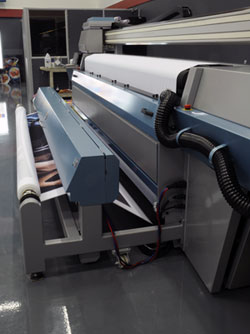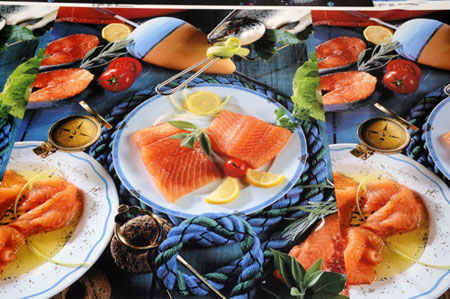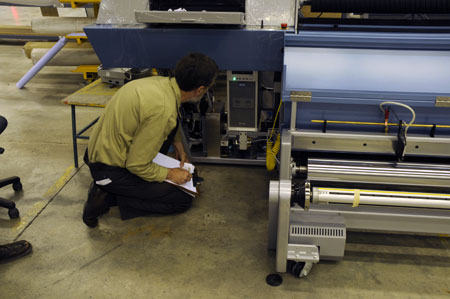 |
Gandinnovations Jeti 3324 AquaJet. |
Issues with early versions of Gandinnovations Jeti 3324 AquaJet dye sublimation direct to fabric inkjet printer reviewed by Nicholas Hellmuth, FLAAR Reports
Gandinnovations Jeti 3324 AquaJet dye sublimation direct to fabric printer
Note: this is not an evaluation of the Agfa AguaJet of 2011; this page is an evaluation of the original Gandinnovations AguaJet with the first two ink sets. Since these printers are being sold used on the open market it is important to know about the early versions of this or any printer. HP Designjet 5000 printers, manufactured eight years ago, are still being sold around the world, so even a printer that is no longer manufactured is still crucial to evaluate. An evaluation of an HP 5000 or 5500 is logically not an evaluation of the replacement printer, the HP Designjet Z6100 or Z6200. It would have been easier to spare the confusion if Agfa had provided a new name. But the lack of a new name is not our fault (nor are the problems of the first two ink sets).
Every ink set, every ink chemistry favors some colors. With the many disperse dye systems the ink is being sublimated, so what you first see on the textile is not the same as the lovely colors that pop out after heat sublimation. The best colors of the AquaJet can be bright reds, bright greens, blues. This system produces good skin colors. The image of the colored chameleon on their test print are excellent.
If the image you are printing is pure graphic design (in other words, not a photograph) you can often make it look better on fabric than you could a photograph. With a photograph often the shadows will lose detail because of the inherent nature of the heavy ink saturation that are needed for textiles.
But if your image is a photograph, it can also turn out gorgeous on a textile printer such as the AquaJet if the photograph is not filled with shadow areas.
At Sign Africa show one printshop bought both the AquaJet and also at the same time bought a Gandinnovations 3348 UV JetSpeed RTR (roll-to-roll UV printer for billboards and banners). The AquaJet is for soft signage on polyster.
Most dye sublimation machines are at entry level. This Gandinnovations Jeti 3324 AquaJet direct to textile dye sublimation is a robust grand-format sized production printer intended for round the clock production. You may notice the heavy-duty fabric feeding rollers have ribs in their rubber-like surface. This is a new trend that I have seen in grand format inkjet printers.
Just realize that most analysts and specialists suggest that you tend to get brighter color with dye sublimation ink onto transfer paper and then use a calendaring heat press. Downside is the added cost of the heat press (but the results are much brighter colors).
 |
Sample printed by Gandinnovations Jeti 3324 AquaJet. |
Gandinnovations Jeti 3324 AquaJet: a work in progress.
The AquaJet by 2009 was somewhat improved over the series of issues and glitches since it was first developed during 2007-2008, but buying a used model from someone should be weighed with caution. For example, evidently in Germany there were issues with early versions. This is true of most brands and models: the first production out the door is often still really in beta stage. Only after a year or so is a complex printer closer to being mature.
The most recent models have retrofitted the several specific needs that called for improvement. However we have not had an opportunity to undertake a site-visit case study of the new version. At both ISA 2009 and FESPA Digital 2009 I was checking on the progress of the current version. So we have no recommendation, pro or con, until it is possible to interview the owner of a recent model, produced in the last month of 2008 or early 2009, and to check how the system is functioning in a real world environment.
Unfortunately all we have heard is that most end-users faced issues with the early generations of the Gandinnovations AquaJet.
The main issues we hear about are ink clogging. The original ink was especially problematical. The second ink was better; but not perfect. Now Agfa has switched to DuPont ink, and we are waiting to learn the improved results. Seemingly they have switched to another ink set beyond that. So I prefer to wait until the Agfa version is finalized, as if they keep changing the ink set it is not realistic to evaluate.
In all cases the printer looked gorgeous in the trade show booth: the printer looked great in the demo room. But after it was out in the real world, then reality set in. The situation was evidently serious enough that some people who are buying the Durst RhoTex are unhappy owners of the early AquaJet.
And now that a newer higher print resolution MTEX is available, one of owners of an early model of AquaJet who are getting rid of their Gandinnovations printer and switching to MTEX. I visited a printshop in Spain that was happy to have switched. He had a newer MTEX; he said he needed higher resolution (available from Epson printheads on the Mimaki JV5) so he could print decor. This would be true of any technology: each printer is good at one set of applications but was not made for other applications. If you want to print flags, the newer Agfa version of the AguaJet could be considered. If you want to print materials for close viewing, then you might wish a smaller picoliter drop size.
Be wary of “Success Stories” that are popular in trade magazines. These rarely admit any downsides of a printer and praise everything about the printer (this is for all brands and all models). Success Stories tend, usually, to be unrealistic: Just look at the Success Stories for the DuPont UV printers: these printers were so bad that even DuPont dropped them! Same with the DuPont textile printer, the Artistri. Even DuPont dropped their own printer!
But the Success Story in the trade magazine praised and praised the DuPont Chinese-made UV printer. Why did they not tell anyone that 75% of the first production run had to be recalled and junked (yes, in landfill). I would expect there were tons of PR releases praising the DuPont Artistri also.
And while in the cautious mode and while mentioning DuPont, be very wary of buying any used DuPont Artistri textile printer with dual carriages. Even their distributors said these had potential issues (they produced wonderful colors with POP, but were a bit finicky and thus required TWO operators to run them: one at the front, one at the back!). That makes operational costs a bit pricy.
Essential before deciding on any brand or model: find (on your own) a printshop that already has the printer you are interested in. Ask the owner and also (separately!) ask the printer operator. In every printshop around the world, the comments by an owner, by a manager, and by the printer operator are a bit different with respect to pros and cons of any printer.
 |
| Recently Nicholas Hellmuth spent some days inside a Gandinnovations Factory. Here is inspecting the Jeti 3324 AquaJet. |
Dye sublimation is for inkjet printers; thermal dye transfer is for desktop sized photo printers
Do not confuse “dye sub” with “thermal dye transfer.” Many desktop photo printers use “dye sub” chemistry, but these are thermal dye transfer ink systems. If the printer uses wax-based ribbons, then it is thermal dye transfer. Kodak, Sony, and other companies make these. Matan had the only wide-format thermal dye transfer printer (Matan Sprinter for example).
Dye sublimation inkjet printing utilizes heating to sublimate the ink
Dye sub means the ink is turned into its full brilliance and saturated color after the application of heat. The heat turns the disperse dye ink into a gas and fixes it in or on top of the material you wish to decorate.
There are two ways to do this: print on transfer paper and sublimate the ink OFF the transfer paper onto the end-product (some kind of a polyester material, or metal coated with polyester if you wish to print onto aluminum or tiles or whatever). Obviously dye sublimation onto hard rigid materials is done with a flatbed heat press. To sublimate banner or billboard sized material you would normally use a calendering machine. This is how the first-generation Gandinnovations dye sub printer system worked.
The second way to sublimate is direct sublimation with disperse dye ink. This is done by placing a heater unit directly onto the front of the printer. This is how the new generation of AquaJet handles the sublimation.
The advantage of inkjet sublimation is that you don’t see the dot structure of the droplets; the sublimation process creates a better image with no evidence of inkjet nozzle technology. You get continuous tone, as in a real old-fashioned photograph. The downside, however, is that you can sublimate only onto a polyester fabric or onto other materials with a polyester receiver coating. Just realize that this is a dye ink, and not intended to last for eternity.
The best way to learn about dye sublimation is to visit SGIA or VISCOM Italy or FESPA (Europe) trade shows. Or visit DigiFab in Los Angeles or New York. or the Yuhan-Kimberly distributors around the world.
Alternatives and Options
Since there is an economic recession these days, it is a time when printshop owners and managers spend more time checking the pros and cons of a printer. Plus, printshop owners tell me that they want to have a viable short list of pertinent competing models so they can be absolutely sure that the model they select is the best for their printshop and their clients.
VUTEk and HP Scitex both had a clever switch-over system. In this manner you can print with solvent inks Monday through Wednesday, and then print with dye-sublimation inks Thursday and Friday. This requires a special solvent-based dye sub ink in order that the ink can flow through the same lines that previously held full-strength normal solvent inks. However these printers are not exhibited at any expo in the last several years.
But with the increased competition in the soft signage business, people are also looking for unique printers, such as a model that has 8 colors or 12 colors. Yuhan-Kimberly offers both. Yuhan is the Korean branch of Kimberly-Clark. So this company is financially solid and can afford to create and maintain good quality. I have been to their factory twice. They make several textile ink chemistries themselves and know enough about textile ink to test and select the best of those chemistries that they do not make themselves. The 12-color printer is the VU-180; this is not UV-cured; it is a grand format textile printer. Unfortunately Keundo was unable to finish this printer and as a result Yuhan-Kimberly disposed of its entire textile printing division (not a clever decision, since textile printing has rebounded in 2010-2011).
The main issue is that not many models are 3.2 meters for adequate production speeds. All this changed when Mimaki launched their 3.2 meter textile printers throughout 2010.
The Keundo printer which I inspected at two textile expos in 2013 was producing weak colors: simply not enough pop. Perhaps they had a bad image as a test image. Until I can go to the Keundo factory and inspect the printer in its demo room, I would be cautious
What’s up for 2014 and coming in 2010
I am under NDA on the next wave of grand format textile printers, but there will be some surprises later in 2011. But if you need your printer now, today, then don’t wait. Compare and contrast the various offerings (such as Yuhan-Kimberly VU-180 or the DigiFab StampaJet).
Also realize that you can print on a variety of soft signage materials with the Durst Rho 320R and Rho 351R (these are both UV-cured). HP latex also prints on some textile materials at 3.2 meter width. However today in 2011 there is much more available: Just realize, however, that latex ink and UV-cured ink are not textile inks; they can print on many materials, therefore also textiles. But the ink tends to stay on the surface, so you can see and feel the ink. If you want a fabric with a better hand, you need a true textile ink.
The first Durst RhoTex (several years ago) is at the expensive end. Many people in the industry said this first generatl Durst textile printer had issues. I noticed that after showing it initially, the printer was rarely exhibited again. But Durst worked hard to update this and now there is a newer model. Various MTEX models are at half the price.
I had hoped that as soon as the Agfa version of the AguaJet is finalized, it will probably also be on people’s short list. Unfortunately Agfa does not have a large enough engineering department remaining, so they totally dropped the AquaJet in 2012-2013 and are now rebranding another printer.
Most people who are familiar with the AquaJet said that the chemicals in the ink and the construction of the Spectra printheads used in the AquaJet resulted in needing frequent replacement of the printheads (a very expensive issue).
One intermediate company offered to change the Spectra heads for Ricoh, but that would require re-engineering the entire ink delivery system. I would not want to recommend changing printheads in any printer unless the company had considerable experience (and until I spoke with people who used such a changeover for six months minimum so that feedback was available).
There are FLAAR Reports on all the Yuhan, DigiFab, and Rho textile printers. Our initial inspection of the Eurotech Mermaid direct-to-fabric disperse dye sublimation 3.2 meter printer was earlier in 2009; it was still in prototype stage and was not adequate at that time. Now the printer has advanced through alpha stage into beta stage but I have not seen it recently. This particular model has not been exhibited internationally under this name in 2013.
The summary is that almost every 3.2 meter textile printer has had endless issues. Gandinnovations worked on the AquaJet for years; Agfa did their best to improve what was left. Both failed to make a printer that satisfied the majority of end-uses. I was also told that the ink delivery system could not deliver ink fast enough when the printer was in fast mode.
If these printers are offered used, I would be careful. Realize however, that for any printer model: some people are totally happy and say that the printer works great. Other people put up with the issues and survive one way or another. And some printshops find the printer really has issues.
When you buy a used printer it’s tough to know which model you will be receiving. And a money-back warranty on a used-printer is not realistic.
In other words, the printer could not produce out in the real world what was promised in advertising claims. This is because Durst is a UV-cured printer company. Gandy is a UV-cured company (and in the past solvent inks also) Eurotech is a solvent printer manufacturer. It is logical if a company is good at making inkjet printers they assume they can make one for textiles also. But the last seven years shows otherwise.
Now you see why the ATPColor printer is appealing: ATPColor is dedicated and devoted for years to one thing: textile ink printers. So they have experience.
I visited a printshop in Germany which had a 3.2m printer from ATPColor. They liked it enough to buy a second one. These printers use Ricoh printheads. Spectra are among my factorite heads, and the managers and team at Spectra are highly regarded in the industry. But some textile inks evidently prefer other printhead technology (in this case Ricoh).
So if you are in the market for a 3.2m textile printer, you can contact ATPColor.
.
Most recently updated Dec. 3, 2013, after hearing from several more sources about potential issues with an Aquajet. Updated March 2011 after again noticing that some printshops need a higher resolution than was available with the earlier Gandinnovations textile printer. First posted September 2008. Updated Feb. 2, 2009, April 6, 2009.